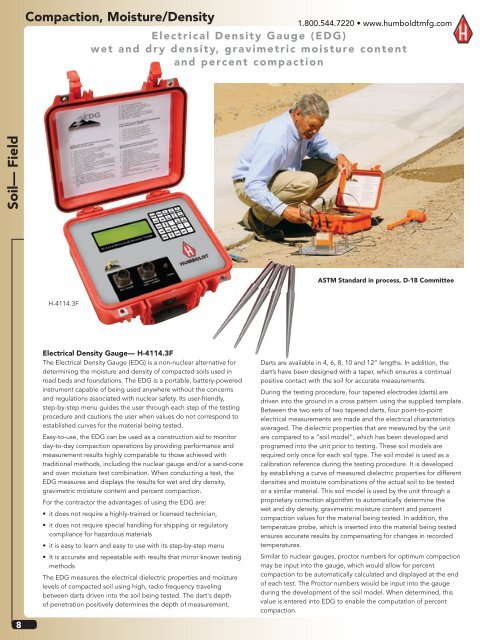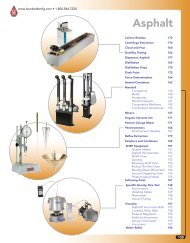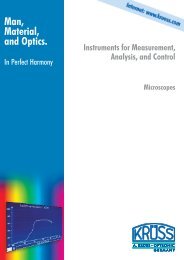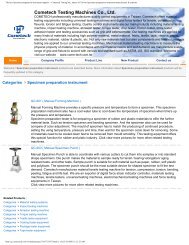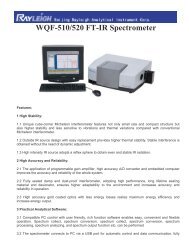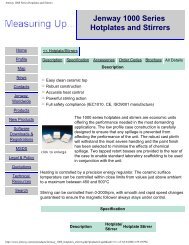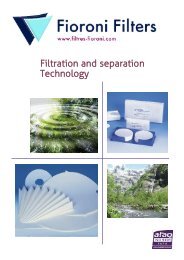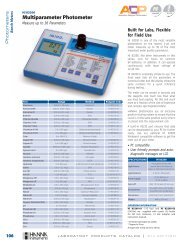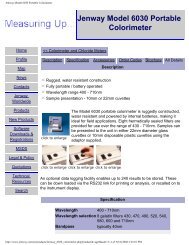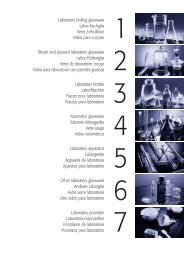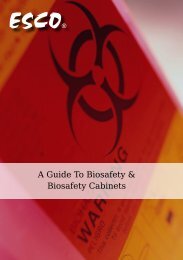Humboldt Catalog - Soil-Field Section - Comlibris
Humboldt Catalog - Soil-Field Section - Comlibris
Humboldt Catalog - Soil-Field Section - Comlibris
You also want an ePaper? Increase the reach of your titles
YUMPU automatically turns print PDFs into web optimized ePapers that Google loves.
<strong>Soil</strong>— <strong>Field</strong><br />
8<br />
Compaction, Moisture/Density<br />
H-4114.3F<br />
1.800.544.7220 • www.humboldtmfg.com<br />
Electrical Density Gauge (EDG)<br />
wet and dry density, gravimetric moisture content<br />
and percent compaction<br />
Electrical Density Gauge— H-4114.3F<br />
The Electrical Density Gauge (EDG) is a non-nuclear alternative for<br />
determining the moisture and density of compacted soils used in<br />
road beds and foundations. The EDG is a portable, battery-powered<br />
instrument capable of being used anywhere without the concerns<br />
and regulations associated with nuclear safety. Its user-friendly,<br />
step-by-step menu guides the user through each step of the testing<br />
procedure and cautions the user when values do not correspond to<br />
established curves for the material being tested.<br />
Easy-to-use, the EDG can be used as a construction aid to monitor<br />
day-to-day compaction operations by providing performance and<br />
measurement results highly comparable to those achieved with<br />
traditional methods, including the nuclear gauge and/or a sand-cone<br />
and oven moisture test combination. When conducting a test, the<br />
EDG measures and displays the results for wet and dry density,<br />
gravimetric moisture content and percent compaction.<br />
For the contractor the advantages of using the EDG are:<br />
• it does not require a highly-trained or licensed technician,<br />
• it does not require special handling for shipping or regulatory<br />
compliance for hazardous materials<br />
• it is easy to learn and easy to use with its step-by-step menu<br />
• It is accurate and repeatable with results that mirror known testing<br />
methods<br />
The EDG measures the electrical dielectric properties and moisture<br />
levels of compacted soil using high, radio frequency traveling<br />
between darts driven into the soil being tested. The dart's depth<br />
of penetration positively determines the depth of measurement.<br />
ASTM Standard in process, D-18 Committee<br />
Darts are available in 4, 6, 8, 10 and 12” lengths. In addition, the<br />
dart’s have been designed with a taper, which ensures a continual<br />
positive contact with the soil for accurate measurements.<br />
During the testing procedure, four tapered electrodes (darts) are<br />
driven into the ground in a cross pattern using the supplied template.<br />
Between the two sets of two tapered darts, four point-to-point<br />
electrical measurements are made and the electrical characteristics<br />
averaged. The dielectric properties that are measured by the unit<br />
are compared to a “soil model”, which has been developed and<br />
programed into the unit prior to testing. These soil models are<br />
required only once for each soil type. The soil model is used as a<br />
calibration reference during the testing procedure. It is developed<br />
by establishing a curve of measured dielectric properties for different<br />
densities and moisture combinations of the actual soil to be tested<br />
or a similar material. This soil model is used by the unit through a<br />
proprietary correction algorithm to automatically determine the<br />
wet and dry density, gravimetric moisture content and percent<br />
compaction values for the material being tested. In addition, the<br />
temperature probe, which is inserted into the material being tested<br />
ensures accurate results by compensating for changes in recorded<br />
temperatures.<br />
Similar to nuclear gauges, proctor numbers for optimum compaction<br />
may be input into the gauge, which would allow for percent<br />
compaction to be automatically calculated and displayed at the end<br />
of each test. The Proctor numbers would be input into the gauge<br />
during the development of the soil model. When determined, this<br />
value is entered into EDG to enable the computation of percent<br />
compaction.


